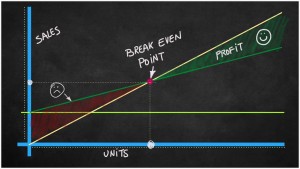Identify your break-even point
 Without knowing your break-even point, you can’t make informed business decisions. Period. But it can be quite daunting finding this break even point. Will breakeven be possible, will it be reachable?
Without knowing your break-even point, you can’t make informed business decisions. Period. But it can be quite daunting finding this break even point. Will breakeven be possible, will it be reachable?
To cover the costs of your business you need to sell enough goods or services to reach your break-even point. Knowing where that point is, and how long it will take you to reach it, can be fundamental to your success. This is especially true if you’re thinking about starting or buying a business. You need to make sure it will be financially viable.
Calculate fixed and variable costs
The first step is to establish your fixed and variable costs.
Fixed Costs
Fixed costs are bills your business always has to pay, regardless of its level of sales. Also known as overheads, they could include:
- Salaries for permanent staff.
- Rent on your premises.
- Insurance.
- Website expenses
- Software subscriptions
Variable Costs
These are costs that increase with your levels of sales – materials and production costs are two examples. Others include sales bonuses, casual wages and freight.
Now work out:
- The total fixed costs bill for the year.
- An average overall variable cost for each product or service sold (the Variable Cost per Unit).
Determine your break-even point
Let’s assume you manufacture shoes with the following details:
- Budgeted fixed costs of $60,000.
- Average cost to make a pair of shoes is $110.
- Average sale price per pair of shoes is $250.
Calculating your break-even point requires the use of a few formulas:
- Sales Price per Unit ($250) minus Variable Costs per Unit ($110) = Contribution Margin per Unit ($140).
- Contribution Margin per Unit ($140) divided by Sales Price per Unit ($250) = Contribution Margin Ratio (0.56).
- Fixed Costs ($60,000) divided by Contribution Margin Ratio (0.56) = Break-even Sales Volume ($107,142).
Based on these calculations, if you sell more than $107,142 of shoes you’ll make a profit. That equates to 429 pairs.
Using your break-even point
Once you’ve worked out your break-even point, the next step is to work out whether the sales volume you’ll need to break even is realistic and achievable. It is time to get honest with your production facilities, your ability to reach those sales and your customer groups who are willing to purchase from you.
You can also use your break-even calculation to see the effect of changes in costs on your business. If you were able to source cheaper materials and reduce the variable cost per pair of shoes, you’d need to sell fewer pairs to break even.
If your sales remained the same, you would make more profit.
For a much easier way to calculate your breakeven point, feel free to download our Breakeven Calculator from our website.
